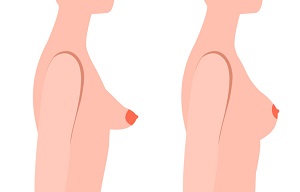
A change in breast shape does not always mean you have cancer, but any change in the appearance or feel of your breasts should always be investigated by a doctor.
Normal Breast Changes
The breasts may show normal changes during different stages of a woman’s life. These changes are mostly guided by hormones.
Changes in breast shape can occur with:
- Menstrual cycle changes
- Pregnancy
- Breastfeeding
- Ageing and menopause
Around the time of your menstrual period, your breasts may feel lumpy, tender or swollen.
During pregnancy, breast glands increase in number and size making the breasts feel lumpy. Near menopause, the breasts may lose fat and become smaller, lumpy and tender. After menopause, fatty tissue in the breasts increases.
A change in breast shape can also occur while taking hormone medications for menopause or birth control.
Breast Change Types
- The most important change is a lump that is seen or felt. It may be present within the breast tissue or under the armpit.
- The nipple may become inverted or produce discharge.
- The skin may become swollen, scaly, red, dimpled or puckered.
Causes of Breast Shape Changes
A change in breast shape can occur with benign conditions such as:
- Enlarged breast lobules (small round lump)
- Scar tissue (painful lump)
- Breast cysts (lump filled with fluid)
- Fat necrosis (painless firm lump after injury or surgery)
- Fibroadenoma (round, small hard lump)
- Mastitis due to a blocked milk duct (while breastfeeding)
Certain conditions such as hyperplasia (growth of abnormal cells) in the ducts and lobules may not be cancerous but can increase your risk of developing breast cancer.
Breast Shape Change Evaluation
How changes in breast shape are evaluated. Your doctor will:
- Review your medical history and family history
- Perform a physical examination
- Order imaging tests such as a mammogram, ultrasound or an MRI
